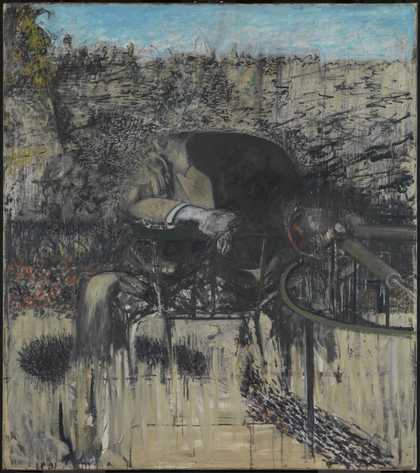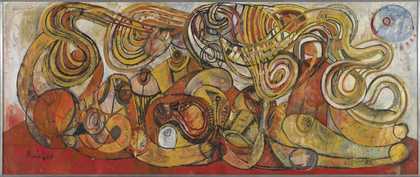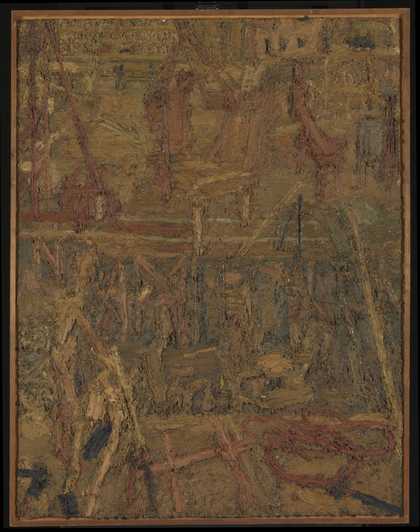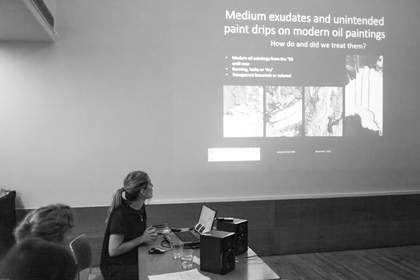To mark the half-way point of the Cleaning Modern Oil Paints (CMOP) project, the project partners met to discuss the progress, outcomes and future plans at Tate on 9–11 November 2016. The meeting culminated in a joint CMOP and Modern Oils Research Consortium (MORC) dissemination event on Friday 11 November, which consisted of a series of short presentations given by the projects members with a view to sharing progress, encouraging discussion, as well as offering a platform for conservators and other professionals to share their research, treatments or any issues relating to the care of modern oil paintings.
To begin the session, Professor Klaas Jan van den Berg (Senior Conservation Scientist, Cultural Heritage Agency, The Netherlands) provided an overview of various phenomenological aspects of twentieth century oil paintings that are currently under investigation including medium exudates, soft and sticky paints, delamination, and solvent sensitivity. He also described a database that is being designed to serve as an illustrated inventory of degradation phenomena associated with twentieth and twenty-first century oil paintings.

Francis Bacon
Figure in a Landscape (1945)
Tate
Professor Aviva Burnstock (Director of the Department of Conservation and Technology at The Courtauld Institute of Art, London, UK) followed this with a fascinating overview of case study water sensitive oil paintings in Tate’s collection by artists such as Frank Auerbach (b.1931), Avinash Chandra (1931–1991), Emil Nolde (1867–1956) and Albert Adams (1929–2006). These case studies were examined as part of CMOP through Courtauld Institute of Art postgraduate easel painting conservation students carrying out collaborative projects with Tate, which highlighted how varied sensitive painting surfaces can be.

Avinash Chandra
Hills of Gold (1964)
Tate
Judith Lee (Conservation Science Researcher, CMOP, Tate, London, UK) followed this by summarising some of the key finding from her in-depth analytical investigation into water sensitive artist oil colour swatches produced by Winsor & Newton (W&N), carried out as part of her AHRC-funded collaborative doctorate. Judith discussed the nature of the polar and acidic chemical species present on swatch surfaces, and how the proportions of the compounds present can differ from the bulk paint film, and with pigment type.
Dr Ilaria Bonaduce (Associate Professor at the Department of Chemistry and Industrial Chemistry of the University of Pisa, Italy) discussed some of the challenges encountered with the chemical analysis of the oil fraction of oil paints. She spoke about the complexities of choosing the correct analytical technique for identifying the different portions of the oil fraction and how many techniques are ideally required to capture the relevant information from these complex paints. She also presented some observations on the identification of additives such as castor wax and shared some recent analysis of the water sensitive W&N oil paint samples that form part of Judith’s CMOP research.

Frank Auerbach
Oxford Street Building Site I (1959–60)
Tate
Dr Bronwyn Ormsby (Principal Conservation Scientist, Tate, London, UK) then presented an overview of another collaborative Courtauld–Tate student research project where a group of surface cleaning systems recently developed for acrylic paints were evaluated for potential for use on water sensitive oil paints. This included a useful methodology for future studies and flagged some potentially useful systems for further investigation, as well as a few problems that need further investigation.
Annette King (Paintings Conservator, Tate) described some of her ongoing research and technical analysis of Pablo Picasso’s Nude Woman in a Red Armchair 1932, which includes some water sensitive paint passages. Judith Lee joined Annette to provide analytical evidence gleaned from samples from both water-sensitive and non-water sensitive paint passages. Her combined analyses provided likely explanations for the water sensitivity encountered on this painting, which closely related to her findings from the W&N artist oil paint swatches.

Fig.4
CMOP Seminar at Tate Britain, London, 10 November 2016
Photo © Mikkel Scharff
To close the presentations, new MORC members Jin Strand Ferrer, Terje Syversen, and Tomas Markevicius from the Munch Museum, Oslo, Norway, discussed the challenges associated with paintings by Edvard Munch (1863–1944) including works with fragile under-bound surfaces, paint delamination as well as tenacious soiling and in some cases soiling that may be considered significant to the history of certain works including bird droppings possibly originating from Munch’s outdoor studio. They outlined some novel cleaning strategies involving the use of enzymatic gels with temperature control facilitated by an IMAT,1 which uses carbon nanotube technology, as well the use of monoatomic oxygen for non-contact surface cleaning, which is the subject of a current grant proposal by the group.
The event was attended by an international audience of conservators, conservation scientists, representatives of artists’ paint manufacturers, interested research partners, lecturers in conservation, and conservation students. The meeting was enthusiastically received by the attendees as a timely update as to the progress of ongoing research taking place as part of both the CMOP and MORC initiatives. It also served as an opportunity for discussion of current conservation practice in relation to challenges posed by a variety of twentieth century paintings.
All CMOP members wish to thank Tate Research, JPI Heritage Plus and all presenters and attendees for making the event a great success.
March 2017
